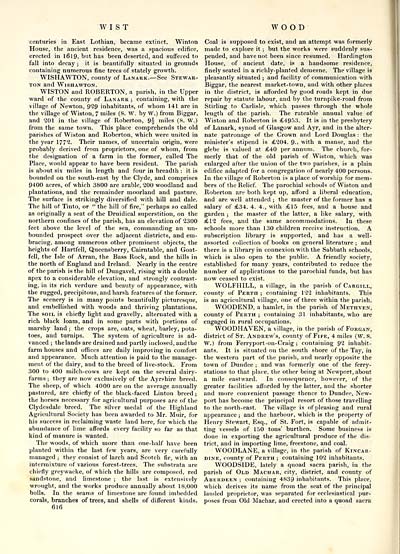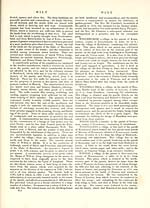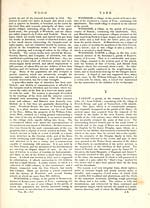Topographical dictionary of Scotland > Volume 2
(624) Page 616 - WIN
Download files
Complete book:
Individual page:
Thumbnail gallery: Grid view | List view

WIST
WOOD
centuries in East Lothian, became extinct. Winton
House, the ancient residence, was a spacious edifice,
erected in 1619, but has been deserted, and suffered to
fall into decay ; it is beautifully situated in grounds
containing numerous fine trees of stately growth.
WISHAWTON, county of Lanark.— See Stewar-
TON and WlSHAWTON.
WISTON and ROBERTON, a parish, in the Upper
ward of the county of Lanark ; containing, with the
village of Newton, 929 inhabitants, of whom 141 are in
the village of Wiston, 7 miles (S. W. by W.) from Biggar,
and 201 in the village of Roberton, 9| miles (S. W.)
from the same town. This place comprehends the old
parishes of Wiston and Roberton, which were united in
the year 1772. Their names, of uncertain origin, were
probably derived from proprietors, one of whom, from
the designation of a farm in the former, called The
Place, would appear to have been resident. The parish
is about six miles in length and four in breadth : it is
bounded on the south-east by the Clyde, and comprises
9400 acres, of which 3800 are arable, 200 woodland and
plantations, and the remainder moorland and pasture.
The surface is strikingly diversified with hill and dale.
The hill of Tinto, or " the hill of fire," perhaps so called
as originally a seat of the Druidical superstition, on the
northern confines of the parish, has an elevation of 2300
feet above the level of the sea, commanding an un-
bounded prospect over the adjacent districts, and em-
bracing, among numerous other prominent objects, the
heights of Hartfell, Queensberry, Cairntable, and Goat-
fell, the Isle of Arran, the Bass Rock, and the hills in
the north of England and Ireland. Nearly in the centre
of the parish is the hill of Dungavel, rising with a double
apex to a considerable elevation, and strongly contrast-
ing, in its rich verdure and beauty of appearance, with
the rugged, precipitous, and harsh features of the former.
The scenery is in many points beautifully picturesque,
and embellished with woods and thriving plantations.
The soil is chiefly light and gravelly, alternated with a
rich black loam, and in some parts with portions of
marshy land ; the crops are, oats, wheat, barley, pota-
toes, and turnips. The system of agriculture is ad-
vanced ; the lands are drained and partly inclosed, and the
farm houses and offices are daily improving in comfort
and appearance. Much attention is paid to the manage-
ment of the dairy, and to the breed of live-stock. From
300 to 400 milch-cows are kept on the several dairy-
farms ; they are now exclusively of the Ayrshire breed.
The sheep, of which 4000 are on the average annually
pastured, are chiefly of the black-faced Linton breed ;
the horses necessary for agricultural purposes are of the
Clydesdale breed. The silver medal of the Highland
Agricultural Society has been awarded to Mr. Muir, for
his success in reclaiming waste land here, for which the
abundance of lime affords every facility so far as that
kind of manure is wanted.
The woods, of which more than one-half have been
planted within the last few years, are very carefully
managed ; they consist of larch and Scotch fir, with an
intermixture of various forest-trees. The substrata are
chiefly greywacke, of which the hills are composed, red
sandstone, and limestone ; the last is extensively
wrought, and the works produce annually about 18,000
bolls. In the seams of limestone are found imbedded
corals, branches of trees, and shells of different kinds.
616
Coal is supposed to exist, and an attempt was formerly
made to explore it ; but the works were suddenly sus-
pended, and have not been since resumed. Hardington
House, of ancient date, is a handsome residence,
finely seated in a richly-planted demesne. The village is
pleasantly situated ; and facility of communication with
Biggar, the nearest market-town, and with other places
in the district, is afforded by good roads kept in due
repair by statute labour, and by the turnpike-road from
Stirling to Carlisle, which passes through the whole
length of the parish. The rateable annual value of
Wiston and Roberton is £4953. It is in the presbytery
of Lanark, synod of Glasgow and Ayr, and in the alter-
nate patronage of the Crown and Lord Douglas : the
minister's stipend is £204. 9-> with a manse, and the
glebe is valued at £40 per annum. The church, for-
merly that of the old parish of Wiston, which was
enlarged after the union of the two parishes, is a plain
edifice adapted for a congregation of nearly 400 persons.
In the village of Roberton is a place of worship for mem-
bers of the Relief. The parochial schools of Wiston and
Roberton are both kept up, afford a liberal education,
and are well attended ; the master of the former has a
salary of £34. 4. 4., with £15 fees, and a house and
garden ; the master of the latter, a like salary, with
£12 fees, and the same accommodations. In these
schools more than 130 children receive instruction. A
subscription library is supported, and has a well-
assorted collection of books on general literature ; and
there is a library in connexion with the Sabbath schools,
which is also open to the public. A friendly society,
established for many years, contributed to reduce the
number of applications to the parochial funds, but has
now ceased to exist.
WOLFHILL, a village, in the parish of Cargill,
county of Perth ; containing 122 inhabitants. This
is an agricultural village, one of three within the parish.
WOODEND, a hamlet, in the parish of Methven,
county of Perth ; containing 31 inhabitants, who are
engaged in rural occupations.
WOODHAVEN, a village, in the parish of Forgan,
district of St. Andrew's, county of Fife, 4 miles (W. S.
W.) from Ferryport-on-Craig ; containing 92 inhabit-
ants. It is situated on the south shore of the Tay, in
the western part of the parish, and nearly opposite the
town of Dundee ; and was formerly one of the ferry-
stations to that place, the other being at Newport, about
a mile eastward. In consequence, however, of the
greater facilities afforded by the latter, and the shorter
and more convenient passage thence to Dundee, New-
port has become the principal resort of those travelling
to the north-east. The village is of pleasing and rural
appearance ; and the harbour, which is the property of
Henry Stewart, Esq., of St. Fort, is capable of admit-
ting vessels of 150 tons' burthen. Some business is
done in exporting the agricultural produce of the dis-
trict, and in importing lime, freestone, and coal.
WOODLANE, a village, in the parish of Kincar-
dine, county of Perth ; containing 102 inhabitants.
WOODSIDE, lately a quoad sacra parish, in the
parish of Old Machar, city, district, and county of
Aberdeen ; containing 4839 inhabitants. This place,
which derives its name from the seat of the principal
landed proprietor, was separated for ecclesiastical pur-
poses from Old Machar, and erected into a quoad sacra
WOOD
centuries in East Lothian, became extinct. Winton
House, the ancient residence, was a spacious edifice,
erected in 1619, but has been deserted, and suffered to
fall into decay ; it is beautifully situated in grounds
containing numerous fine trees of stately growth.
WISHAWTON, county of Lanark.— See Stewar-
TON and WlSHAWTON.
WISTON and ROBERTON, a parish, in the Upper
ward of the county of Lanark ; containing, with the
village of Newton, 929 inhabitants, of whom 141 are in
the village of Wiston, 7 miles (S. W. by W.) from Biggar,
and 201 in the village of Roberton, 9| miles (S. W.)
from the same town. This place comprehends the old
parishes of Wiston and Roberton, which were united in
the year 1772. Their names, of uncertain origin, were
probably derived from proprietors, one of whom, from
the designation of a farm in the former, called The
Place, would appear to have been resident. The parish
is about six miles in length and four in breadth : it is
bounded on the south-east by the Clyde, and comprises
9400 acres, of which 3800 are arable, 200 woodland and
plantations, and the remainder moorland and pasture.
The surface is strikingly diversified with hill and dale.
The hill of Tinto, or " the hill of fire," perhaps so called
as originally a seat of the Druidical superstition, on the
northern confines of the parish, has an elevation of 2300
feet above the level of the sea, commanding an un-
bounded prospect over the adjacent districts, and em-
bracing, among numerous other prominent objects, the
heights of Hartfell, Queensberry, Cairntable, and Goat-
fell, the Isle of Arran, the Bass Rock, and the hills in
the north of England and Ireland. Nearly in the centre
of the parish is the hill of Dungavel, rising with a double
apex to a considerable elevation, and strongly contrast-
ing, in its rich verdure and beauty of appearance, with
the rugged, precipitous, and harsh features of the former.
The scenery is in many points beautifully picturesque,
and embellished with woods and thriving plantations.
The soil is chiefly light and gravelly, alternated with a
rich black loam, and in some parts with portions of
marshy land ; the crops are, oats, wheat, barley, pota-
toes, and turnips. The system of agriculture is ad-
vanced ; the lands are drained and partly inclosed, and the
farm houses and offices are daily improving in comfort
and appearance. Much attention is paid to the manage-
ment of the dairy, and to the breed of live-stock. From
300 to 400 milch-cows are kept on the several dairy-
farms ; they are now exclusively of the Ayrshire breed.
The sheep, of which 4000 are on the average annually
pastured, are chiefly of the black-faced Linton breed ;
the horses necessary for agricultural purposes are of the
Clydesdale breed. The silver medal of the Highland
Agricultural Society has been awarded to Mr. Muir, for
his success in reclaiming waste land here, for which the
abundance of lime affords every facility so far as that
kind of manure is wanted.
The woods, of which more than one-half have been
planted within the last few years, are very carefully
managed ; they consist of larch and Scotch fir, with an
intermixture of various forest-trees. The substrata are
chiefly greywacke, of which the hills are composed, red
sandstone, and limestone ; the last is extensively
wrought, and the works produce annually about 18,000
bolls. In the seams of limestone are found imbedded
corals, branches of trees, and shells of different kinds.
616
Coal is supposed to exist, and an attempt was formerly
made to explore it ; but the works were suddenly sus-
pended, and have not been since resumed. Hardington
House, of ancient date, is a handsome residence,
finely seated in a richly-planted demesne. The village is
pleasantly situated ; and facility of communication with
Biggar, the nearest market-town, and with other places
in the district, is afforded by good roads kept in due
repair by statute labour, and by the turnpike-road from
Stirling to Carlisle, which passes through the whole
length of the parish. The rateable annual value of
Wiston and Roberton is £4953. It is in the presbytery
of Lanark, synod of Glasgow and Ayr, and in the alter-
nate patronage of the Crown and Lord Douglas : the
minister's stipend is £204. 9-> with a manse, and the
glebe is valued at £40 per annum. The church, for-
merly that of the old parish of Wiston, which was
enlarged after the union of the two parishes, is a plain
edifice adapted for a congregation of nearly 400 persons.
In the village of Roberton is a place of worship for mem-
bers of the Relief. The parochial schools of Wiston and
Roberton are both kept up, afford a liberal education,
and are well attended ; the master of the former has a
salary of £34. 4. 4., with £15 fees, and a house and
garden ; the master of the latter, a like salary, with
£12 fees, and the same accommodations. In these
schools more than 130 children receive instruction. A
subscription library is supported, and has a well-
assorted collection of books on general literature ; and
there is a library in connexion with the Sabbath schools,
which is also open to the public. A friendly society,
established for many years, contributed to reduce the
number of applications to the parochial funds, but has
now ceased to exist.
WOLFHILL, a village, in the parish of Cargill,
county of Perth ; containing 122 inhabitants. This
is an agricultural village, one of three within the parish.
WOODEND, a hamlet, in the parish of Methven,
county of Perth ; containing 31 inhabitants, who are
engaged in rural occupations.
WOODHAVEN, a village, in the parish of Forgan,
district of St. Andrew's, county of Fife, 4 miles (W. S.
W.) from Ferryport-on-Craig ; containing 92 inhabit-
ants. It is situated on the south shore of the Tay, in
the western part of the parish, and nearly opposite the
town of Dundee ; and was formerly one of the ferry-
stations to that place, the other being at Newport, about
a mile eastward. In consequence, however, of the
greater facilities afforded by the latter, and the shorter
and more convenient passage thence to Dundee, New-
port has become the principal resort of those travelling
to the north-east. The village is of pleasing and rural
appearance ; and the harbour, which is the property of
Henry Stewart, Esq., of St. Fort, is capable of admit-
ting vessels of 150 tons' burthen. Some business is
done in exporting the agricultural produce of the dis-
trict, and in importing lime, freestone, and coal.
WOODLANE, a village, in the parish of Kincar-
dine, county of Perth ; containing 102 inhabitants.
WOODSIDE, lately a quoad sacra parish, in the
parish of Old Machar, city, district, and county of
Aberdeen ; containing 4839 inhabitants. This place,
which derives its name from the seat of the principal
landed proprietor, was separated for ecclesiastical pur-
poses from Old Machar, and erected into a quoad sacra
Set display mode to: Large image | Transcription
Images and transcriptions on this page, including medium image downloads, may be used under the Creative Commons Attribution 4.0 International Licence unless otherwise stated. ![]()
| Gazetteers of Scotland, 1803-1901 > Topographical dictionary of Scotland > Volume 2 > (624) Page 616 - WIN |
|---|
| Permanent URL | https://digital.nls.uk/97368618 |
|---|
| Description | Volume II: From Keanlochbervie to Zetland. |
|---|---|
| Attribution and copyright: |
|

